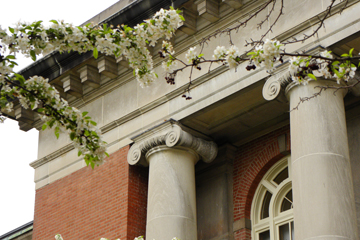
04/04/2016
SUNY Cortland wants to help community college students earn a bachelor’s degree.
Although about 75 percent of community college students begin their two-year programs with the goal of transferring to a four-year college, only 25 to 35 percent actually make the leap, according to a recent study.
The obstacles that interrupt their progress are varied: financial difficulties, personal or family problems and academic weaknesses to name just a few. Community colleges also enroll a high number of adult, working students; financially disadvantaged students; and first-generation college students, all of whom may face significant challenges.
To help these students meet those challenges and move from a local community college to a successful career at SUNY Cortland, the College is partnering with Tompkins Cortland Community College (TC3) and SUNY Broome Community College to create a seamless, resource-filled pathway to a bachelor’s degree.
“I think people are starting to see there is a connection between a two-year and a four-year experience,” said Carol Van Der Karr, SUNY Cortland’s associate provost for academic affairs. “Students don’t see this as, ‘All of a sudden, my life at college begins when I come to Cortland.’ They began two or three years ago, planning to come to Cortland.”
The project aims to build a well-defined route for ambitious students, starting from their first days at the community college through the transfer process and on to baccalaureate completion. All along the way, they would get consistent support from SUNY Cortland.
A key aspect of the initiative will be SUNY Cortland’s hiring of a mobility transfer advisor who will spend time at all three campuses regularly, working directly with students and faculty at each institution.
This Completion Path Collaborative program is a four-year pilot made possible through a $240,000 grant to the College by the SUNY Expanded Investment and Performance Fund. It is one of several new initiatives launched at various SUNY institutions in an effort to help meet SUNY’s goal of awarding 150,000 degrees annually across the 64-campus system by 2020. SUNY graduated 93,009 students annually in the 2012-13 academic year, according to information provided on its current Fast Facts page. Successful programs will become system-wide models.
The advisor, who will have background in admissions, academic advising or student services, will go beyond planning the client’s most efficient course selection strategy. He or she will make informed referrals for students, linking them with services on their two-year campus that address their specific needs. This could be academic tutoring, financial aid advising, counseling or some other barrier to successful degree completion.
Additionally, discipline-specific collaborations will take place among faculty of the three colleges, to make sure all academic transfer needs are met. The grant also provides funds to support a liaison at each community college to serve as a link between the campus and the mobility transfer advisor. And planned SUNY software eventually will help the colleges plan and track each student’s progress. The project also proposes field trips for interested community college students to visit and establish positive contacts on the Cortland campus.
“This is an emergent model,” Van Der Karr said. “In SUNY, many of the two- and four-year campuses have informal relationships. This is probably a more formalized system and it is certainly a more intensive system because having someone there every week, that’s pretty intensive.”
The project’s initiators would be pleased to see a 5 percent increase in transfer student retention at SUNY Cortland, where the current baseline is 85 percent; as well as an increase in two-year completion, including reverse transfer, of 5 to 10 percent; and a 5 percent increase in four-year degree completion.
The collaborators also hope to include a yearly faculty symposium to bring the critical people from the different campuses together in a specific discipline.
“One example might be bringing together all the science faculty at once from the three colleges,” said Carol Costell Corbin, assistant director for transfer credit services. “The faculty might ask each other, ‘What are their students’ skills? What do they need, for example, in how well they do lab work?’”
The project will incorporate SUNY’s unique “transfer finder” function that is being developed on the DegreeWorks online platform, Costell Corbin noted. The function will let students compare what they have completed with degree programs across the SUNY system.
“The best results come from interactions with a person,” which the online system won’t replace, she noted.